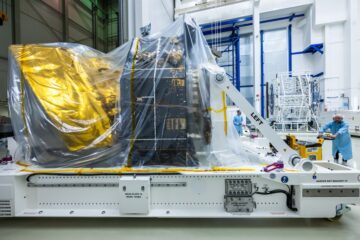This week’s edition of our Astronomy & You series is a piece on the applications of Magnetic Resonance Imaging (MRI) to our everyday lives. The following piece was written by Gabriele Giovannini; vice-President of the IAU’s Division B and full Professor in the Department of Physics and Astronomy in Bologna University, Italy. His main field of interest in astronomy is in in radio observations of the cosmos.
Techniques from radio astronomy that allow signals from widely spaced telescopes to be combined together have found application in medical diagnosis.
To obtain high angular resolution images of the sky in the radio band is not easy because of the long wavelength of radio waves. The finest resolution possible, known as the diffraction limit, depends on the wavelength divided by the size of the telescope. For the strong line of atomic hydrogen at 21 cm, obtaining the arcsecond resolution of optical telescopes, would require a diameter of about 50 km, impossibly large to build for a single telescope.
To overcome this problem, astronomers use the technique of interferometry to obtain high-resolution images of the radio-sky. Interferometry simulates the effect of a very large dish, by electronically combining the signal from many small, single-dish, radio telescopes. The resolution is given by the greatest separation of the dishes, not the size of a single dish.

This great improvement it is possible because the output from the combination of telescopes oscillates with time since the projected distance of each pair of telescopes, as seen by the source, changes as the Earth rotates. The technique of combining data from multiple telescopes to produce a single image seemingly created from a telescope having the size of the entire collection is known as ‘aperture synthesis’. It was first developed in 1974. The separation of the telescopes can be continental at times, enabling resolutions far superior to the best optical telescopes. Special data reduction techniques were developed to combine the data and also to obtain high quality images, even when only a few telescopes are used.
This powerful imaging technique can be applied to many different fields. One important application is Magnetic Resonance (MR) to enhance the imaging details and to reduce the scan time in medical diagnoses.
Magnetic Resonance Imaging (MRI) uses powerful magnets and radio frequency pulses to polarize and excite single protons of water molecules in the human tissue. When the pulses are turned off, the protons ‘relax’ and emit radio waves. These waves are seen by radio frequency receivers in the MRI machine, recorded and processed into an image similar to an interferometric image.

The quality and resolution of the images have greatly improved in recent years. While astronomers expand networks radio telescopes to see increasingly faint and distant objects, medicine takes advantage to see things obscured within the human body. MRI quality and resolution has improved thanks to powerful magnets, digital receivers and processors, and imaging software. This allows to reduce scan times and improve imaging resolution at lower cost.




0 Comments